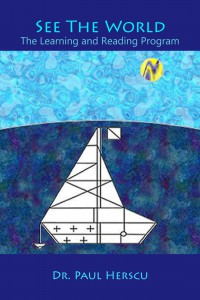See the World: The Learning and Reading Program
 Excerpts from the INTRODUCTION – by Paul Herscu ND, MPH
Excerpts from the INTRODUCTION – by Paul Herscu ND, MPH
This book offers parents a new model for understanding children who have trouble processing information. Your child’s difficulties in reading or mathematics, in conceptualizing and completing a series of steps in a logical sequence, and in social interactions are difficulties felt as terrific stress on the child and family alike. This book teaches parents about the learning/thought process, and empowers parents and educators with practical, concise exercises for working with such children. These easy to learn approaches lead to measurable improvement in your child’s ability to understand and process information, to solve problems and learn more effectively.
First I want to briefly describe part of my model of how the brain works, describe to you what I see as the process in learning. Then I will move on to describe how this process can be hampered and most importantly, how this process can be improved upon. After presenting these general concepts, the rest of the book will follow logically.
I believe the brain is designed to function using two separate approaches, two separate strategies when learning. In one approach, the mind gathers a massive number of discrete, individual items of information to arrive at an overarching perception, at a whole perception. In the other approach, the brain more or less starts at the overarching perception and then endeavors to fit all the discrete pieces into that perception. The brain is designed to ‘see the pieces’ AND to ‘see the whole,’ and by using both strategies, to arrive at a clear perception of what is being looked at, read, seen, heard or experienced. These perceptual sets come first. Afterwards, learning occurs. (More on this in a few pages.) The premise of this book–what you will recognize in your child–is that not everyone has easy access to both of these skills at will, not all children or adults have an easy ability to use both strategies seamlessly. As a result, there is a certain set of problems, a certain set of symptoms that arise, a certain set of difficulties that are experienced. For some, these symptoms lead physicians to make one of several specific diagnoses, while others elude a precise diagnosis altogether. The strategies and exercises in this book are designed to help address the problem of not being able to use both perceptual strategies.
I want to highlight that even though this book is primarily aimed at children who are having difficulties in school and in life, primarily different sorts of learning difficulties, the exercises described in this book should not be thought of in a limited manner, as they apply outside the school setting as well. To a certain extent we all have learning strengths and learning difficulties. Our abilities to comprehend our surroundings are always somewhat clouded or influenced by our perspectives, which lead to different sorts of distortions. Biological and behavioral sciences speak to this point clearly enough. The bottom line is that we all have to learn, we all have to absorb and integrate information gathered from our environment. And, we are all limited, to one extent or another, in being able to accomplish that integration perfectly. It is just that for some people these challenges stand out more and interfere with many aspects of life.
Related, if there has been a disruption to the brain’s activity, such as after a stroke or after a head injury, these same skills are compromised, and have to be specifically retrained. In short, this program is not just for children who are failing, and really, it is not just for children.
As a result, I would like to offer the following advice. This book is aimed at those without diagnoses but also at those with the diagnoses of learning disabilities, reading disabilities, math disabilities, auditory processing problems, central processing problems, etc. The list is long, and frankly somewhat depressing to me. I dislike all these terms. They dehumanize the child to a mere diagnosis. While the terms help in the diagnosis of a set of symptoms, they limit the ability to describe what really ails the child. As a result, many of the diagnoses are then followed by the psychologist saying that there is nothing really to be done to fix it, the problem just has to be managed correctly and that this child’s hardwiring cannot really be altered. Some recommendations made are very good and help the child to compensate for weakness. In the program I will lay out, I aim to diminish and eliminate those weaknesses.


